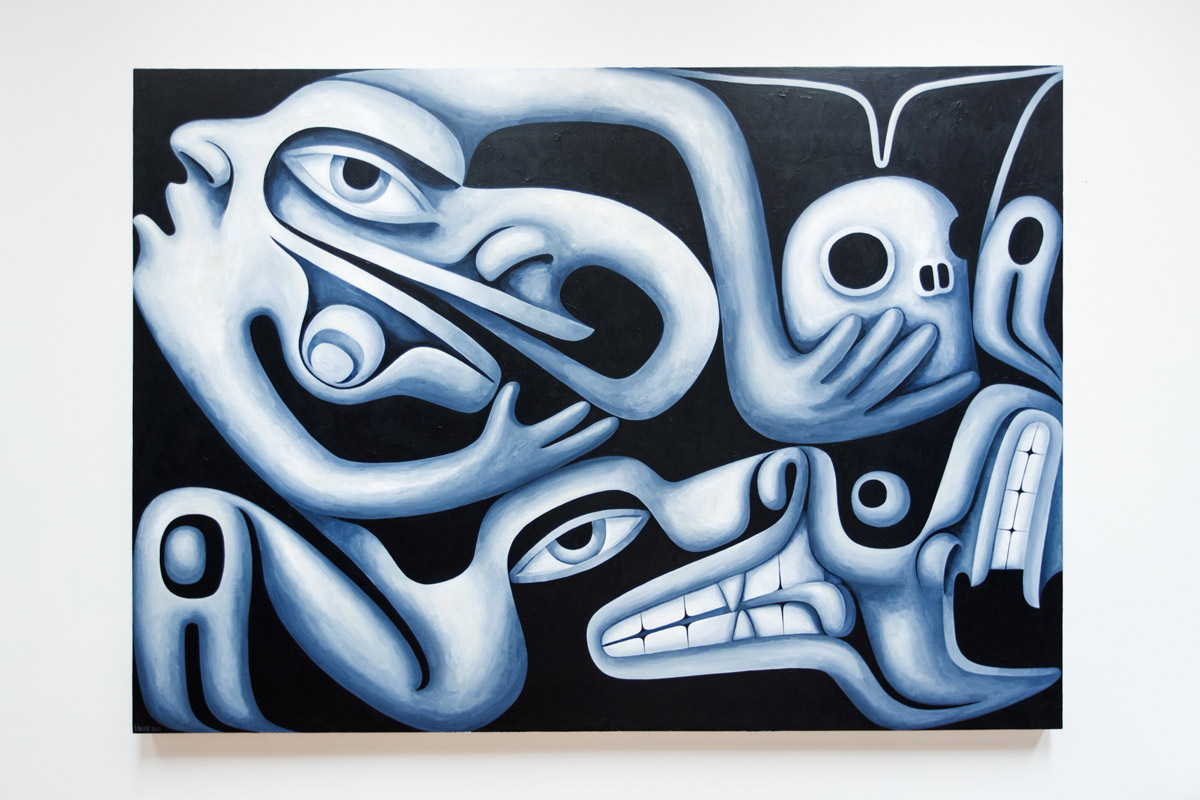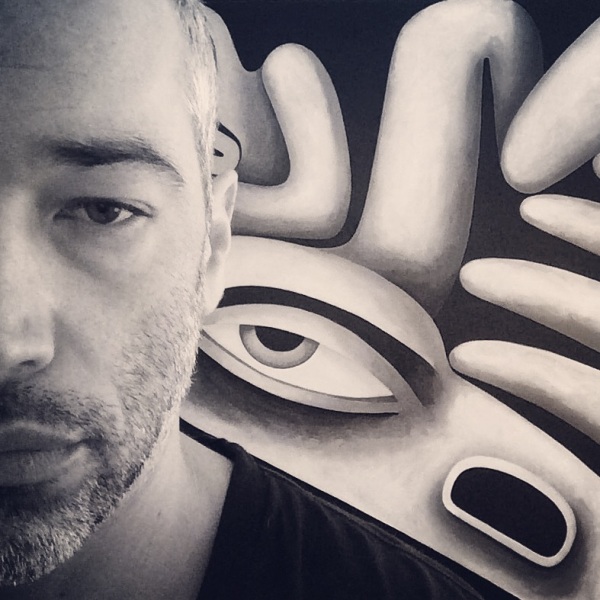
Photo: Paul Hodgson




‘Line As Language’ opens May 19th at Burrard Arts Foundation 108 East Broadway Vancouver B.C.
www.mfineart.ca
www.burrardarts.org
Shawn Hunt Uses Art to Tell His Stories
by Alexandra Best | May 11, 2016 | BAF Studio, Recent Posts |
We spoke with Shawn Hunt, B.C. based Heiltsuk artist, on his upcoming series of paintings, entitled Line as Language.
AB: Where are you based out of?
SH: Currently I’m working on the Sunshine Coast. I’ve spent time in Vancouver recently working in East Van, but I prefer the country life to the city life.
AB: Did you go to school for art?
SH: Yes, I did go to art school. I went to Capilano University when I was in collage. They had an excellent studio art program there at one time. I graduated with a diploma in Studio Art. I then went to the University of British Columbia where I received my BFA. After UBC I continued my education by working with my dad Bradley Hunt who is a renowned Heiltsuk carver and artist. After working with my father I went on to apprentice in painting with Lawrence Paul Yuxweluptun for a few years.
AB: Can you tell us a bit about your heritage?
SH: Sure, my father is Heiltsuk from Waglisla, also known as Bella Bella in British Columbia. My mother is from Langham Saskatchewan. Her family is Canadian with Scottish ancestry.
AB: Do you often work with your family? Is your whole family artistic?
SH: My Dad Bradley Hunt and my brother Dean Hunt are both artists. My mom was a teacher, although now that she is retired, she dabbles in the arts as well. I’m fortunate enough to share a studio with my dad and brother. Sometimes we collaborate with each other formally, and other times informally. We are all very close.
AB: You work with lots of sculpture and painting – what is your preferred medium, and what are the benefits of each?
SH: I also work in jewelry as well. I don’t think I could chose a favourite medium. I like the variety. It keeps me fresh, and I believe it helps me to progress. Each medium informs the other. For this exhibition I am just showcasing my paintings, but I’m also working on another exhibition for later in the year that will be exclusively sculptures.
AB: What themes are you working on in your upcoming show, Line As Language?
SH: I feel like my Heiltsuk culture has always been described as having an oral history, meaning that we did not write down our history, instead we told stories to pass on our history and our mythology. I think just as importantly, we have had a visual culture history. Our art is a language. It is not something that can be directly translated into English, and I think that this just has to be accepted. Our style of art, Northern art, has been referred to as formline art. The formline is basically the black line that acts like a skeleton for the red elements in the design. The design style is very complex, yet at the same time incredibly simple, like a paradox; magic in its truest sense. I’m trying to work with this line, its characteristics and it’s principles in new ways. To be free with it, yet retaining its integrity. Its a puzzle, a game, an obsession. It’s a language of line that is constantly evolving, and I’m continuing to learn the language as I go.
AB: Can you tell us bit more about the concept of Neoformline?
SH: Neoformline is just a term that I started using to describe a style of Northwest Coast art where the artist was pushing the boundaries of the formline style; when he or she was trying to use formline in new and sometimes unconventional ways. There are quite a few artists that have done this and I am by no means the first. I’m just putting my own spin on it. This art form is a very old one, it goes back to the beginning. It is a continuum. What artists like myself and others are doing today will be built on by the next generation, just as we built our artwork on the work of the artists that came before us.
AB: A lot of your past work depicts traditional Heiltsuk history – what are some stories that you are exploring in this current show?
SH: I feel like I am trying to answer the big questions, to try and seek out the answers to life’s mysteries. Creation, purpose, why we are here, who are we, and what are we here to do. I don’t have the answers, I probably never will, but that’s not the point. The point is to ask the questions and to seek the answers. In fact the more I learn, and the more I work, the more I realize that I know so very little. It’s like that with life and it’s like that with the art.
AB: Some of your past work has elements of satire – I’m thinking of Trickster and Three Watchmen. Is there any irony in your current show?
SH: No I don’t think so. I think with some of those earlier works I was trying to be clever. I think like many artists I have that trickster nature about me, a rebellious thinker. With this body of work I’m trying to make work that is raw and real. Trying to make work that is based less on intellect and more on emotion. I try not to overthink it. Sometimes I have the feeling of just be a passive observer of what comes out. It’s a process and I’m trying to get in touch with it. I am trying to let go of a perceived outcome. I don’t know. It’s difficult to articulate because I realize I am just at the beginning of this journey.
AB: What do you find the most inspirational?
SH: That’s tough to pin down. I collect inspiration from everywhere. I try to take it in through all of my senses. I’m not sure where my work comes from or why it materializes in this way. Inspiration is incredibly varied and random. All of these paintings begin first as drawings. Drawing has always been like my therapy. I draw incessantly and this stuff just pours out. I am happy that it does because I enjoy the process and am fascinated by the result.
Catch Shawn Hunt’s latest exhibition, Line as Language, at Burrard Arts Foundation (108 E Broadway). Opening May 19th.
Text by Alexandra Best and Shawn Hunt

